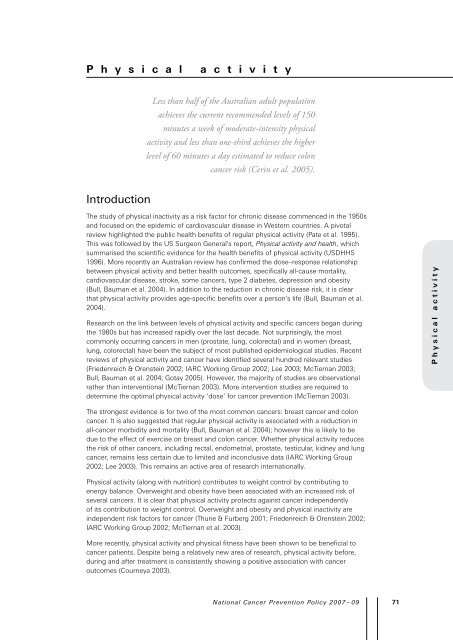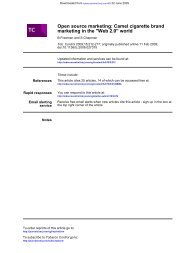National Cancer Prevention Policy - Tobacco Control Supersite
National Cancer Prevention Policy - Tobacco Control Supersite
National Cancer Prevention Policy - Tobacco Control Supersite
Create successful ePaper yourself
Turn your PDF publications into a flip-book with our unique Google optimized e-Paper software.
P h y s i c a l a c t i v i t y<br />
Introduction<br />
Less than half of the Australian adult population<br />
achieves the current recommended levels of 150<br />
minutes a week of moderate-intensity physical<br />
activity and less than one-third achieves the higher<br />
level of 60 minutes a day estimated to reduce colon<br />
cancer risk (Cerin et al. 2005).<br />
The study of physical inactivity as a risk factor for chronic disease commenced in the 1950s<br />
and focused on the epidemic of cardiovascular disease in Western countries. A pivotal<br />
review highlighted the public health benefits of regular physical activity (Pate et al. 1995).<br />
This was followed by the US Surgeon General’s report, Physical activity and health, which<br />
summarised the scientific evidence for the health benefits of physical activity (USDHHS<br />
1996). More recently an Australian review has confirmed the dose–response relationship<br />
between physical activity and better health outcomes, specifically all-cause mortality,<br />
cardiovascular disease, stroke, some cancers, type 2 diabetes, depression and obesity<br />
(Bull, Bauman et al. 2004). In addition to the reduction in chronic disease risk, it is clear<br />
that physical activity provides age-specific benefits over a person’s life (Bull, Bauman et al.<br />
2004).<br />
Research on the link between levels of physical activity and specific cancers began during<br />
the 1980s but has increased rapidly over the last decade. Not surprisingly, the most<br />
commonly occurring cancers in men (prostate, lung, colorectal) and in women (breast,<br />
lung, colorectal) have been the subject of most published epidemiological studies. Recent<br />
reviews of physical activity and cancer have identified several hundred relevant studies<br />
(Friedenreich & Orenstein 2002; IARC Working Group 2002; Lee 2003; McTiernan 2003;<br />
Bull, Bauman et al. 2004; Gotay 2005). However, the majority of studies are observational<br />
rather than interventional (McTiernan 2003). More intervention studies are required to<br />
determine the optimal physical activity ‘dose’ for cancer prevention (McTiernan 2003).<br />
The strongest evidence is for two of the most common cancers: breast cancer and colon<br />
cancer. It is also suggested that regular physical activity is associated with a reduction in<br />
all-cancer morbidity and mortality (Bull, Bauman et al. 2004); however this is likely to be<br />
due to the effect of exercise on breast and colon cancer. Whether physical activity reduces<br />
the risk of other cancers, including rectal, endometrial, prostate, testicular, kidney and lung<br />
cancer, remains less certain due to limited and inconclusive data (IARC Working Group<br />
2002; Lee 2003). This remains an active area of research internationally.<br />
Physical activity (along with nutrition) contributes to weight control by contributing to<br />
energy balance. Overweight and obesity have been associated with an increased risk of<br />
several cancers. It is clear that physical activity protects against cancer independently<br />
of its contribution to weight control. Overweight and obesity and physical inactivity are<br />
independent risk factors for cancer (Thune & Furberg 2001; Friedenreich & Orenstein 2002;<br />
IARC Working Group 2002; McTiernan et al. 2003).<br />
More recently, physical activity and physical fitness have been shown to be beneficial to<br />
cancer patients. Despite being a relatively new area of research, physical activity before,<br />
during and after treatment is consistently showing a positive association with cancer<br />
outcomes (Courneya 2003).<br />
<strong>National</strong> <strong>Cancer</strong> <strong>Prevention</strong> <strong>Policy</strong> 2007 – 09<br />
1<br />
P h y s i c a l a c t i v i t y




